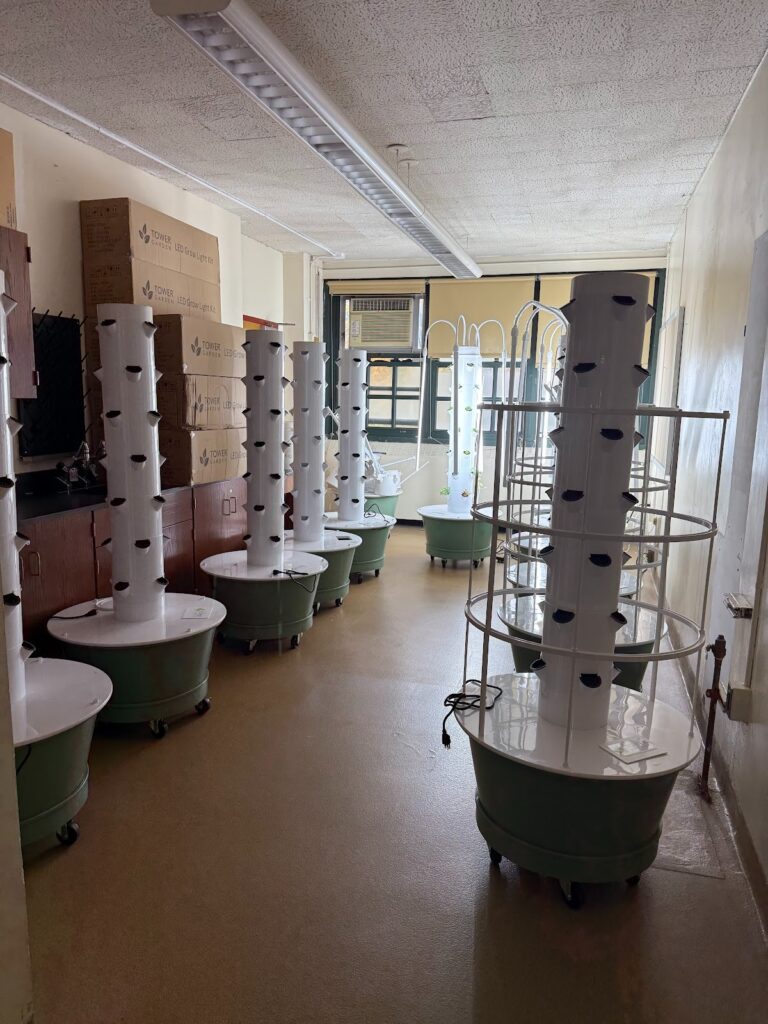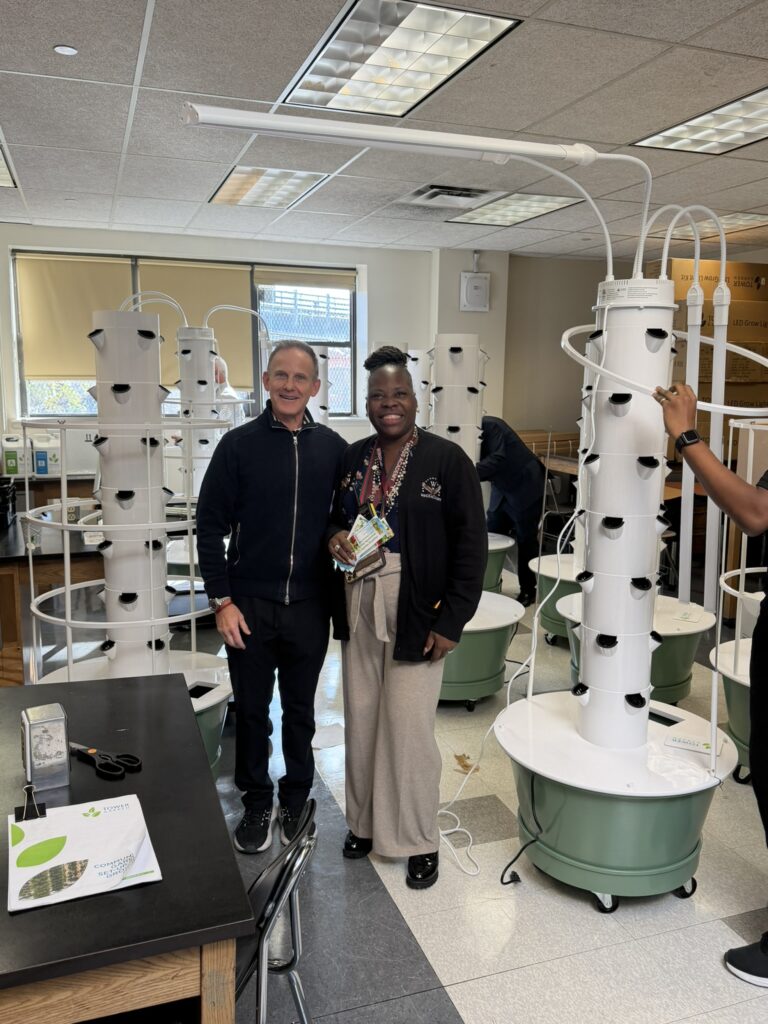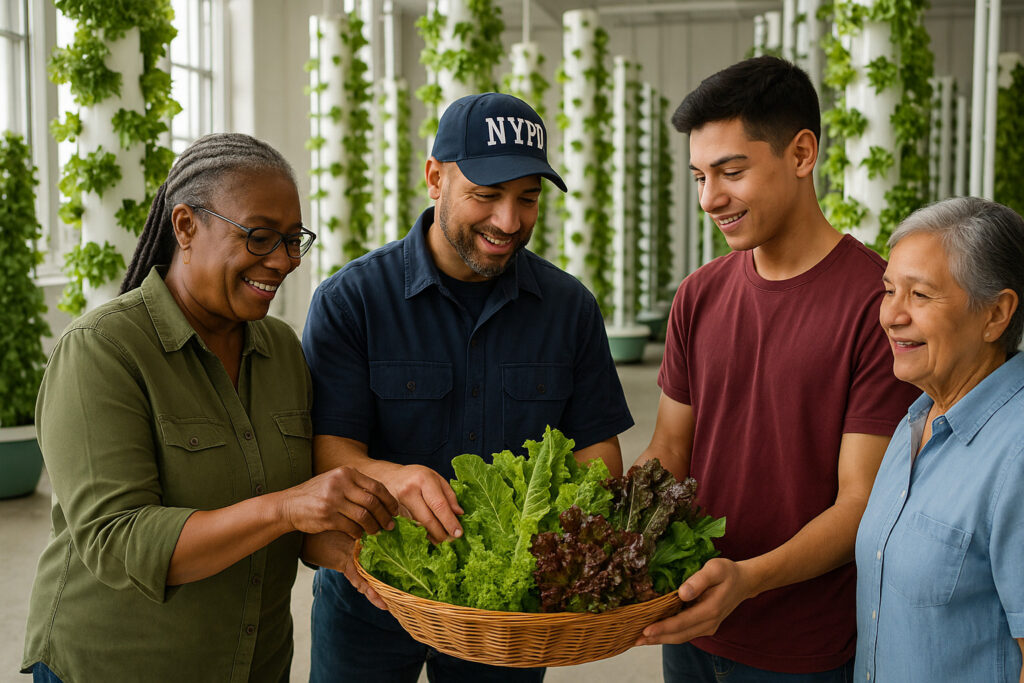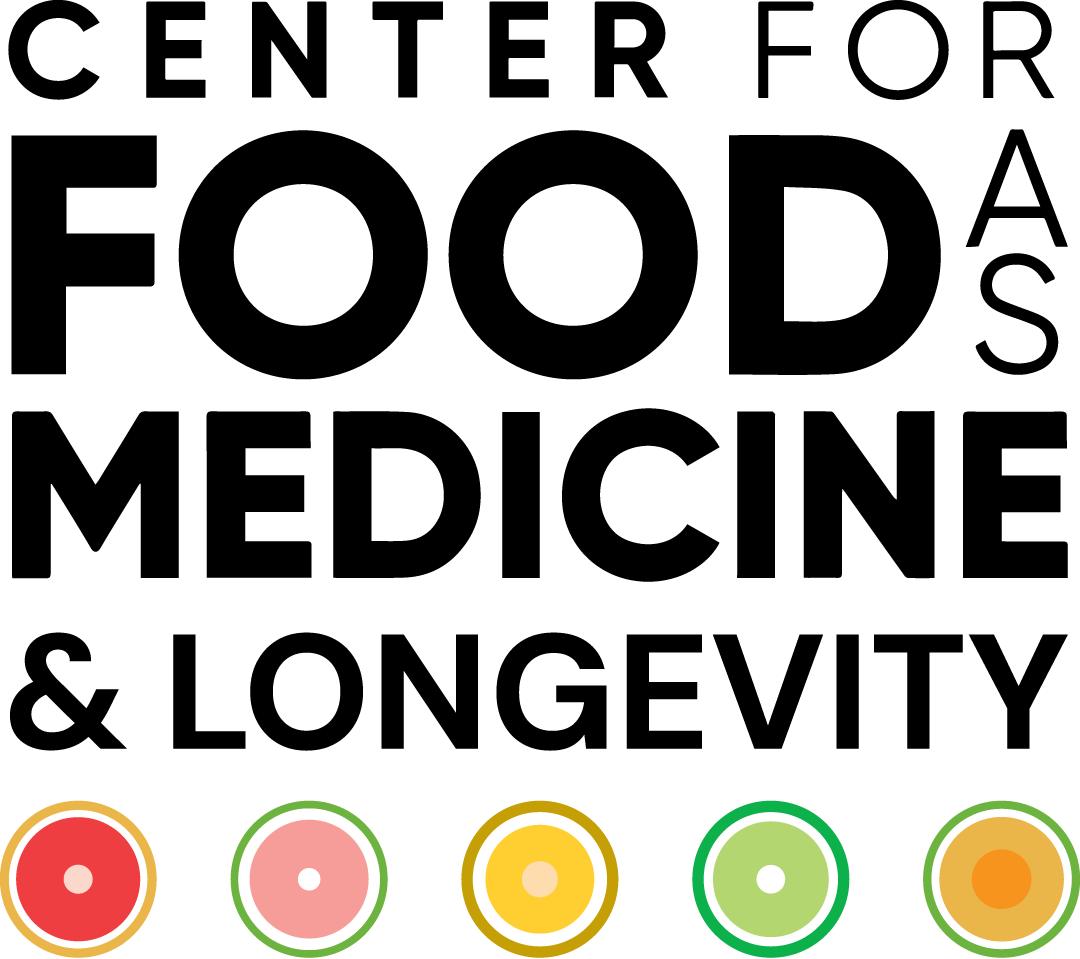The Bronx Sustainable Hydroponic Community Farm Network
A Program of the Center for Food As Medicine and Longevity (CFAM)
The Story Behind Food for Change
In the heart of the South Bronx, where vibrant culture meets grinding poverty, a quiet crisis unfolds daily. Families struggle not only to find affordable, healthy food but also to find connection, trust, and hope in their own neighborhoods. Children grow up seeing police as adversaries, not partners. Seniors sit isolated in their apartments, their cultural wisdom unshared and undervalued. Students graduate without understanding where food comes from or how to care for their own health. And through it all, the fabric of community—the social bonds that hold neighborhoods together—continues to fray.
Food for Change emerges from a simple but powerful truth: food is the foundation of society and a universal language. It cuts through barriers of age, background, and institutional role. It creates spaces where people who might never otherwise meet can work side-by-side with shared purpose. It transforms charity into dignity, dependency into sovereignty, and strangers into neighbors.
This initiative recognizes that food insecurity cannot be separated from social disconnection. A food pantry may fill a stomach for a day, but it doesn’t rebuild the trust between a teenager and a police officer. A SNAP card may help a family afford groceries, but it doesn’t connect a lonely senior with a young person hungry to learn. A community garden may grow vegetables, but it doesn’t necessarily bridge the institutional divides that fracture urban neighborhoods.

Food for Change does all of this—and more.
Imagine a high school in the Bronx where students don’t just study biology from textbooks—they become grower-scientists, tending vertical hydroponic towers that produce hundreds of pounds of fresh lettuce, herbs, and peppers each month. These same students then walk to nearby senior centers at Tilden Towers, R.A.I.N. Gun Hill, and R.A.I.N. Boston East, where elders teach them how to prepare traditional Puerto Rican and Dominican dishes, sharing stories of resilience and recipes passed down through generations.
Now imagine a police officer—not in uniform responding to a call, but in work clothes, hands in nutrient-rich water, helping those same students check pH levels and harvest tomatoes at the NYPD OPTIONS Center. Not as an authority figure, but as a partner. Not enforcing, but nurturing. Not surveilling, but serving.
Finally, imagine all three groups—students, seniors, and officers—gathering quarterly around tables filled with food they grew together at sites across Community Board 12, cooking meals that honor cultural traditions, sharing laughter and stories in both English and Spanish, building the kind of trust that can only come from genuine partnership and shared accomplishment.

This is Food for Change. This is what happens when we recognize that the solution to our most complex urban challenges—food insecurity, social isolation, institutional distrust, chronic disease—must be as interconnected as the problems themselves.
We are not simply creating farms. We are creating third spaces—safe gathering places beyond home and work where community is rebuilt one seed, one harvest, one shared meal at a time. We are not simply distributing food. We are rebuilding social capital—the networks, bonds, and trust that research identifies as essential for community health, resilience, and wellbeing. We are not simply teaching nutrition. We are transforming relationships—proving that when people work together toward shared goals, stereotypes dissolve, humanity emerges, and new possibilities take root.

Food for Change will establish 25-30 hydroponic farms across the Bronx—beginning with three schools and the NYPD OPTIONS Center, then expanding to seven senior centers including the R.A.I.N. network sites, and ultimately creating a comprehensive network throughout Community Board 12 and surrounding neighborhoods. Together, these sites will produce 120,000-360,000 pounds of fresh, culturally relevant produce annually, all distributed free to residents. But more importantly, they will produce something that cannot be measured in pounds: transformed relationships, rebuilt trust, and restored dignity.
This is not charity. This is community empowerment.
This is not about giving people food. This is about growing it together.
This is not a program. This is a movement.
The South Bronx is ready. And with your partnership, we will prove that change begins not with words, but with seeds—and that when we grow food together, we grow hope together.
The Crisis: Why the South Bronx Needs This Now
The Belmont/Tremont, East Tremont, and West Farms neighborhoods face a perfect storm of interconnected challenges affecting 84,000 residents: 54% rely on SNAP benefits (NYC’s highest rate), 22% have diabetes, 35% are obese, median household income of just $32,381, and 94% are limited-English speaking households (54% Spanish-speaking). In a community that is 67% Latino and 25% Black, food assistance programs often provide produce that doesn’t match Puerto Rican, Dominican, and Caribbean culinary traditions. But beyond hunger, this community faces eroded trust between residents and police, seniors isolated without purpose, and youth disconnected from cultural heritage. These challenges demand solutions as interconnected as the problems themselves.
The Solution: Five Components Working as One
Food for Change establishes 25-30 working hydroponic farms integrating serious food production with comprehensive resource navigation through unprecedented tri-sector partnerships:
1. Working Urban Farms – 300-420 vertical tower systems (12-14 per site) producing 120,000-360,000 pounds annually of culturally relevant fresh produce—leafy greens, cilantro, recao, peppers, tomatoes—distributed free to 9,000-24,000 families. Production value: $360,000-$1,080,000 annually.
2. Tri-Sector Partnerships – Students maintain production systems and deliver harvests to senior centers. Seniors determine crop priorities based on culinary traditions and teach traditional cooking. Police officers work side-by-side with community members maintaining farms. All become community ambassadors sharing information about SNAP enrollment, food pantries, and nutrition programs. Research shows hydroponic farming networks foster social capital through community participation, knowledge sharing, and collective action (Prastyo et al., 2023; Kirby et al., 2021; Ilieva et al., 2022).
3. Community Table Events – Quarterly bilingual gatherings where students, seniors, and officers cook traditional Puerto Rican, Dominican, and Caribbean meals with farm produce, creating vital “third spaces” for healing and connection (Ilieva et al., 2022; Feinberg et al., 2020).
4. Hyperlocal Health Resource Navigation – GIS mapping of all food resources in Community Board 12, coalition of 50+ stakeholders, bilingual outreach campaigns reaching 50,000+ residents, and farm sites serving as dual-purpose hubs providing both food and information.
5. Education & Workforce Development – Bilingual programming in hydroponic science, nutrition education, cultural food preservation, and urban agriculture workforce training led by Chief Nutrition Officer Gayle Reichler, MS, RDN, with curricula co-created with Green Bronx Machine.
Network Sites & Infrastructure
Pilot Sites: NYPD OPTIONS Center (1932 Arthur Avenue), Wings Academy (1122 E 180th St), M.S. 129 (2055 Mapes Ave)
Expansion: 15-18 additional schools, community centers, and police precincts to reach 25-30 sites
Each site features 12-14 vertical tower systems (132-154 growing ports) producing 400-1,000 pounds monthly and serving 30-80 families. Strategic placement creates neighborhood saturation, ensuring consistent food supply and enabling the network to function as a coordinated food production system.
Expected Impact
Food Security: Distribute 120,000-360,000 pounds annually to 9,000-24,000 families; increase SNAP enrollment by 20%; increase farmers’ market participation by 30%
Social Capital: Create 25-30 “third spaces” where meaningful work builds authentic relationships across generations and institutions; fundamentally transform police-community relationships through care-centered partnership; build coalition of 50+ organizations
Community Capacity: Ensure 80% of residents know available food resources within 12 months; distribute 10,000+ bilingual resource guides; train community ambassadors
Health & Cultural Preservation: Support chronic disease management; preserve cultural food traditions; empower communities to grow their own food rather than depending on external charity
Economic Value: $360,000-$1,080,000 in produce distributed free; household budget relief; urban agriculture workforce training and employment opportunities

Evidence-Based Model
Research confirms that multi-site community-based hydroponic networks improve food security by increasing local availability, reducing external dependence, and enhancing resilience (Rahmania et al., 2024; De Sousa et al., 2024; Gumisiriza et al., 2021). These projects foster social capital through community participation and collective action, especially when organized as networked efforts (Prastyo et al., 2023; Kirby et al., 2021; Ilieva et al., 2022). Urban agriculture enhances social bonds, reduces tensions, and creates platforms for healing (Liu et al., 2022; Feinberg et al., 2020). When institutions actively engage through sustained involvement, trust can improve (Siegner et al., 2018; Ilieva et al., 2022). Key distinction: This program prioritizes production capacity and meaningful community work over symbolic activities, which research shows creates more sustained impact (Surya et al., 2020; Colson-Fearon & Versey, 2022).
Advancing Health Equity
Food for Change centers equity by operating in a federally recognized disadvantaged community with concentrated poverty, food insecurity, and chronic disease burden. All programming is bilingual, honoring that 54% speak Spanish as primary language. Crops and recipes honor Latino and Black food traditions. Police participation represents a paradigm shift from enforcement to care, building trust in communities historically harmed by over-policing. Hyperlocal Health ensures language, literacy, and technology barriers don’t exclude residents from resources. The model empowers residents to control food production rather than depending on charity, creating food sovereignty and pathways to economic opportunity through workforce development.
Implementation & Sustainability
Year 1: Install systems at 5-6 pilot sites (60-84 towers), hire core team, establish Hyperlocal Health coalition and GIS mapping, begin production operations (24,000-60,000 pounds)
Year 2: Expand to all 25-30 sites (300-420 towers), implement full network programming, complete comprehensive evaluation and develop replication materials (120,000-360,000 pounds annually)
Long-Term Sustainability: Once systems installed and partnerships established, sites maintained by trained community members. Schools incorporate farms into curriculum, senior centers integrate programming into activities, police precincts embed partnerships into wellness initiatives. Hyperlocal Health sustained through CFAM’s existing infrastructure. Partnership with Senator Rivera ensures policy advocacy and integration into city frameworks. Replication consulting revenue supports continued operation.
Why This Matters & Call to Action
Food is the foundation of society and a universal language. When a child plants seeds alongside a police officer, stereotypes dissolve. When a senior teaches traditional recipes at a Community Table, cultural heritage is preserved. When residents grow their own food, dignity is restored and power shifts from charity to sovereignty.
Food for Change proves that the solution to food insecurity and social disconnection begins with community empowerment, not dependency. By establishing 25-30 hydroponic farms where unlikely partners work together, this initiative will produce 120,000-360,000 pounds annually, serve 9,000-24,000 families, create thriving community spaces where authentic partnerships flourish, transform police-community relationships, and establish a replicable model proving that food is a powerful change agent for social transformation.
The Bronx is ready. The community is hungry—not just for food, but for connection, dignity, and hope. The partners are committed. The infrastructure is designed. The methodology is proven. The research validates the approach. The moment is now.
Join us in using food as a powerful change agent to nourish bodies, rebuild trust, strengthen social capital, and transform communities from the inside out.
When we plant seeds together, we grow hope together. When we harvest together, we celebrate together. When we eat together, we become community together.
Food for Change: Growing more than vegetables—growing connection, trust, and transformation.
Center for Food As Medicine and Longevity (CFAM)
17 E. 17th St., FL 4, New York, NY 10003
Email: info@foodmedcenter.org
501(c)(3) tax-exempt organization


